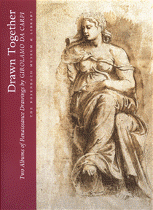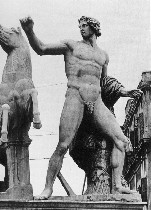 Anyone who relishes a mystery and the world of antiquarian books should delight in the little show now at the Rosenbach Museum and Library. I made it to the press preview for the exhibit of 29 Renaissance drawings by Girolamo da Carpi, and I got the chef’s tour by show curator Gudrun Dauner and Rosenbach Director Derick Dreher (image, the catalog cover).
Anyone who relishes a mystery and the world of antiquarian books should delight in the little show now at the Rosenbach Museum and Library. I made it to the press preview for the exhibit of 29 Renaissance drawings by Girolamo da Carpi, and I got the chef’s tour by show curator Gudrun Dauner and Rosenbach Director Derick Dreher (image, the catalog cover).After that lovely beginning, I confess I let my notes marinate in my notebook until it got so far back in the scheme of things that I moved on to the next notebook and I can barely decipher what I wrote. But this show is up until Dec. 4, so I felt like I had all the time in the world to get this post up. Mistake. It’s better to write things when the notes are fresh.
The show and its catalog are about two albums of sketches by Girolamo, one at the Rosenbach and one in Turin, plus several pages of sketches that made their way into the British Museum. The exhibit delivers a scholarly argument, proving with spills and blots what page was next to what page in Girolamo’s original notebooks (this was my favorite part). “Girolomo was as important as Michelangelo or Raphael at that time, and no one now knows that,” said Dauner, who is German and speaks with excellent accented English.
 The goal of the exhibit and catalog for Dauner, the world’s top Girolamo expert, is to restore his reputation as one of the great Renaissance masters–Girolamo executed works commissioned by Pope Julius III and the Estes. His work, according to the catalog, was widely admired by people like Vasari, and Girolamo had the polymathic skills of a fine Renaissance artist–architecture, landscape architecture, painting, anatomical drawings for a medical text, and sculpture (image, drawing from the Rosenbach’s collection, bull and two heads of Pan by Giralomo).
The goal of the exhibit and catalog for Dauner, the world’s top Girolamo expert, is to restore his reputation as one of the great Renaissance masters–Girolamo executed works commissioned by Pope Julius III and the Estes. His work, according to the catalog, was widely admired by people like Vasari, and Girolamo had the polymathic skills of a fine Renaissance artist–architecture, landscape architecture, painting, anatomical drawings for a medical text, and sculpture (image, drawing from the Rosenbach’s collection, bull and two heads of Pan by Giralomo).The goal for Dreher, of course, is to cement the importance of another part of the Rosenbach’s collection of antiquarian books. And it’s also for dealers and collectors, who now have a guide should a Girolamo pass into their hands. The catalog is thing of beauty, in English and Italian, written by Dauner and edited by Dreher and Nicolas Barker.
 The exhibit and catalog use Girolamo’s studies of sculptures to prove where he traveled and what he saw (photo of a Roman sculpture “Horse Tamer” or “Diascuros,” 2nd century A.D., and, below, Girolamo’s drawing of this sculpture as well as of the statue of Juno in the collection of Cardinal Paolo Emilio Cesi, both confirming his presence in Rome). .
The exhibit and catalog use Girolamo’s studies of sculptures to prove where he traveled and what he saw (photo of a Roman sculpture “Horse Tamer” or “Diascuros,” 2nd century A.D., and, below, Girolamo’s drawing of this sculpture as well as of the statue of Juno in the collection of Cardinal Paolo Emilio Cesi, both confirming his presence in Rome). .
But it’s the story of the twin albums–who acquired them when, how the pages got separated and reshuffled, how the previous attempt at restoration threatened the integrity of the drawings–that drew me in. The exhibit includes some of the British Museum drawings as well as some of the drawings in the Rosenbach’s collection
 It is not clear to me that Girolamo is a master on the level of Michelangelo, but he is certainly an important artist who has been overlooked and certainly deserves restoration into art history. Some of the drawings, especially the draperies, are spectacular, and eventually become fodder for work Girolamo later produces. I always find that progression of artistic thinking interesting.
It is not clear to me that Girolamo is a master on the level of Michelangelo, but he is certainly an important artist who has been overlooked and certainly deserves restoration into art history. Some of the drawings, especially the draperies, are spectacular, and eventually become fodder for work Girolamo later produces. I always find that progression of artistic thinking interesting.
Most of the drawings were made between 1540 and 1555, and often they are paired with the sculpture from which the drawings were made. As always at the Rosenbach, there’s plenty of labeling and stuff to read, so you can piece the argument of the show together and come away having learned something worth learning, not to mention having seen something worth seeing.









